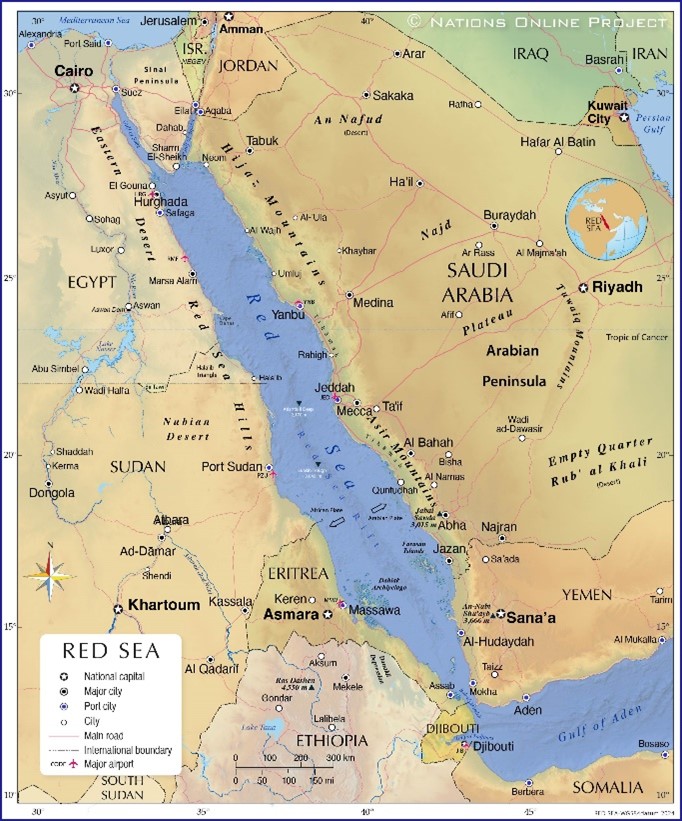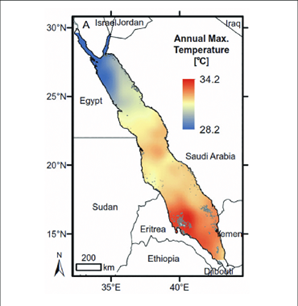Sustainability and innovations in Red Sea aquaculture
By Tancredi Fumagalli - Technical Sales Advisor
The Red Sea is a water basin strongly intertwined with human history and even today continues to play a central role, especially for the countries bordering it. It is estimated that approximately 37 million people depend on activities in the Red Sea more directly, with tourism and fishing being the most important. In this context, an increasingly relevant role will be played by aquaculture, which must be able to become a fundamental source of livelihood, both food and economic, for these populations without negatively interfering with such a precious natural environment. In this short article we delve into the main activities that will take place in the Red Sea aquaculture in the near future, looking at the role of sustainability in all this.
The Red Sea
The Red Sea is a sea located between Africa to the east and Asia to the west, covering an area of 438,000 km². The coastline is shared by 9 different countries, and it is considered a basin with low productivity due to the low flow of natural nutrients from the land through rainfall or floods (Tesfamichael and Pauly, 2016). The Red Sea is an important tourist destination primarily because of its extensive coral reefs, serving as a hotspot for coral reef ecology, hosting more than 1200 species of fish, which have formed due to its extraordinary depth (averaging 490m, with a maximum peak of 3000m) and an efficient natural system of water recirculation from the Indian Ocean through the Gulf of Aden (Fig.1).
Fig.1: Political map of the Red Sea

These two physical factors only partially mitigate the high salinity caused by excessive water evaporation, leaving it an extremely salty basin with an average salinity of 36‰ in the south and 41‰ near the Suez Canal in the north. Despite the complex environmental conditions, dictated by salinity and high-water temperatures, the various countries bordering it, through their internal policies, have made the Red Sea one of the most interesting places in the global aquaculture landscape, where numerous challenges will need to be met with corresponding innovations.
Aquaculture
Fishery and aquaculture represent strategically relevant sectors for the countries surrounding the Red Sea, serving as vital sources for subsistence, food security, and nutrition, particularly in terms of protein, for numerous coastal communities. It is estimated that over 85,000 individuals are directly engaged in these sectors, with a notable preference for fishery (reaching 177,000 tons in 1993, stabilizing around 120 tons/year since 2010). While aquaculture is still in its nascent stage of development for several of these countries, it holds immense potential to revolutionize fish production, aiming to alleviate pressure on fish stocks and broaden access to fish products for a broader population. Obtaining precise data on the total volume of farmed fish within the basin poses challenges due to the involvement of multiple countries. However, it is evident that the figures continue to ascend. For instance, Saudi Arabia's production escalated from 2,700 tons in 1995 to 26,000 tons in 2009, surpassing 140,000 tons in 2022 (Tim Huntington, Poseidon Aquatic Resource Management Ltd, pers. Comm, and FAO). Saudi Arabia appears to be the most dynamic and invested nation in the Red Sea region. Currently, the most ambitious project is spearheaded by Topian Aquaculture, the food company affiliated with NEOM, the monumental urban development project introduced in 2017 with a value exceeding 500 billion. They have set a lofty objective of achieving an annual production of 600,000 tons of fish products by 2030, facilitated by a joint venture with Tabuk Fisheries Company (TFC), which presently yields 5,000 tons annually of farmed fish, specialized in European sea bream (Sparus aurata), Barramundi (Lates calcarifer), and the Meagre (Argyrosomus regius). Both governmental entities and private sectors perceive the advancement of technologies for cultivating indigenous species as pivotal for creating a robust local aquaculture sector (TFC has started some trials on closed-cycle breeding of Sobaity seabream (Sparindetex hasta), a native carnivorous species commonly found in the Arabian Gulf). Simultaneously, the premier tourism regeneration initiative in the region, Red Sea Global, has initiated a non-binding collaboration (Memorandum of Understanding) with Blue Planet Ecosystems, a Vienna-based startup adept at fostering sustainable fish products in urban and desert settings by replicating natural aquatic ecosystems in a Recirculating Aquaculture System (RAS). In 2016, the Kingdom of Saudi Arabia, in conjunction with FAO, published an Atlas delineating potential areas for cage aquaculture in the Red Sea to stimulate prospective investors' interest in the sector. On the opposite side of the Red Sea, Egypt stands out as the foremost protagonist in African aquaculture (yielding 71.5% of the entire continent's production, amounting to 920,000 tons, FAO 2022). In 2017, it inaugurated the "Ghaliound project" aimed at attaining an annual output of 6,000 tons of shrimp and 13,800 tons of fish, predominantly in the Kafr El-Sheikh region, and thus, the Mediterranean Sea. This currently appears to be its principal focal point for fish farming. Other countries bordering the Red Sea seem to be evaluating the prospects offered by aquaculture. Jordan and Israel are excluded from the discussion due to their limited coastline. In Sudan are primary farmed Nile Tilapia and catfish in ponds operate in the Nile, predominantly in an extensive or semi-extensive manner (10,000 tons of production in 2020). In Eritrea, farming primarily focuses on freshwater species and shrimp, while Yemen according to FAO 2024 data, currently hosts only two aquaculture facilities situated near the Gulf of Aden. The primary production pertains to shrimp (Indian white shrimp, Penaeus indicus, and Green tiger shrimp, Penaeus semisulcatus).
Challenges and ambitions
In an exceptionally intricate setting, characterized by distinct environmental factors such as salinity and water temperature (Fig.2), coupled with the region's robust tourism industry (with Egypt aspiring to double its 15 million tourists from 2023 within five years), aquaculture in the Red Sea must prioritize sustainability in both present and future times. It operates amidst a rich and unique aquatic biodiversity, with 10% of species exclusive to the region, making responsible environmental stewardship imperative.
Fig.2: The Sea Surface Temperature (SST) gradient across the Red Sea. Shown are the highest recorded SSTs during the period of 1982-2015 (modified from Fine et al., 2019).

ResourceWatch reports that in the Red Sea and Gulf of Aden region, coral reefs in different ways benefit 37 million people, with 8.5 million relying heavily on them for sustenance and livelihoods. Concurrently, aquaculture plays a pivotal role in addressing the escalating demand for high-nutrient seafood products in an area marked by rapid population growth.
The challenge for aquaculture in the Red Sea lies in harmonizing innovation and productivity with sustainability principles. Initiatives such as The Red Sea Development Company's (TRSDC) project aim to establish networks of marine protected areas, fostering the restoration of fish populations crucial for ecosystem regeneration. Additionally, efforts to combat and mitigate overfishing, exemplified by the RedSeaFish project led by the Food and Agriculture Organization (FAO) and the Global Environment Facility (GEF), are essential for promoting sustainable fisheries management across the expansive marine ecosystem of the Red Sea.
In this context, the direction set by aquaculture aligns with the imperative of sustainability, signaling a progressive and responsible approach towards harnessing the region's aquatic resources for the benefit of both present and future generations.
ResourceWatch reports that in the Red Sea and Gulf of Aden region, coral reefs in different ways benefit 37 million people, with 8.5 million relying heavily on them for sustenance and livelihoods. Concurrently, aquaculture plays a pivotal role in addressing the escalating demand for high-nutrient seafood products in an area marked by rapid population growth.
The challenge for aquaculture in the Red Sea lies in harmonizing innovation and productivity with sustainability principles. Initiatives such as The Red Sea Development Company's (TRSDC) project aim to establish networks of marine protected areas, fostering the restoration of fish populations crucial for ecosystem regeneration. Additionally, efforts to combat and mitigate overfishing, exemplified by the RedSeaFish project led by the Food and Agriculture Organization (FAO) and the Global Environment Facility (GEF), are essential for promoting sustainable fisheries management across the expansive marine ecosystem of the Red Sea.
In this context, the direction set by aquaculture aligns with the imperative of sustainability, signaling a progressive and responsible approach towards harnessing the region's aquatic resources for the benefit of both present and future generations.
Sources
Aquaculture production (metric tons) - Saudi Arabia | Data (worldbank.org)
Coral Reefs: Red Sea and Gulf of Aden | Resource Watch
Ghalion The largest fish farming farm in the Middle East-SIS
How this mega-project will make Egypt the continent's largest fish producer (youtube.com)
Major milestone for Saudi Arabian native bream reproduction | The Fish Site
Red Sea Aquaculture Co. - Responsible Seafood Advocate (globalseafood.org)
ReWilding the Red Sea ECO : ECO Autumn 2021 (ecomagazine.com)
Saudi Arabia's aquaculture ambitions advanced through Topian joint venture | SeafoodSource
South Sudan - Fishery and Aquaculture Country Profiles (fao.org)
The State of World Fisheries and Aquaculture 2022 (fao.org)
Topian Strengthens Saudi Arabia’s Aquaculture Industry (neom.com)